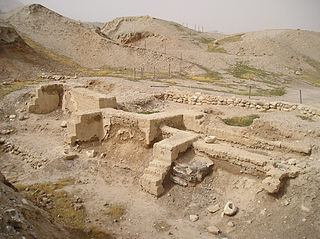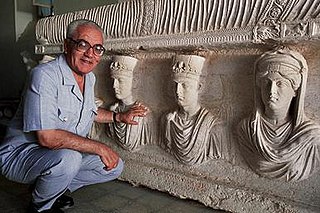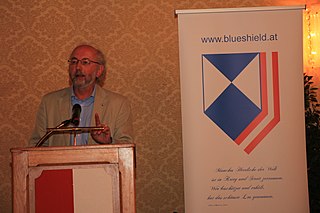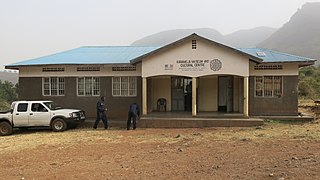Related Research Articles

The Euphrates is the longest and one of the most historically important rivers of Western Asia. Together with the Tigris, it is one of the two defining rivers of Mesopotamia. Originating in Turkey, the Euphrates flows through Syria and Iraq to join the Tigris in the Shatt al-Arab, which empties into the Persian Gulf.

The Levant is an approximate historical geographical term referring to a large area in the Eastern Mediterranean region of Western Asia. In its narrowest sense, it is equivalent to the historical region of Syria, which included present-day Syria, Lebanon, Jordan, Israel, Palestine and most of Turkey southwest of the middle Euphrates. In its widest historical sense, the Levant included all of the Eastern Mediterranean with its islands; that is, it included all of the countries along the Eastern Mediterranean shores, extending from Greece to Cyrenaica in eastern Libya.

Petra, originally known to its inhabitants as Raqmu or Raqēmō is a historic and archaeological city in southern Jordan. It is adjacent to the mountain of Jabal Al-Madbah, in a basin surrounded by mountains forming the eastern flank of the Arabah valley running from the Dead Sea to the Gulf of Aqaba. The area around Petra has been inhabited from as early as 7000 BC, and the Nabataeans might have settled in what would become the capital city of their kingdom as early as the 4th century BC. Archaeological work has only discovered evidence of Nabataean presence dating back to the second century BC, by which time Petra had become their capital. The Nabataeans were nomadic Arabs who invested in Petra's proximity to the incense trade routes by establishing it as a major regional trading hub.

The Southern Levant is a geographical region encompassing the southern half of the Levant. It corresponds approximately to modern-day Israel, Palestine, and Jordan; some definitions also include southern Lebanon, southern Syria and/or the Sinai Peninsula. As a strictly geographical description, it is sometimes used by archaeologists and historians to avoid the religious and political connotations of other names for the area.

Hisham's Palace is an important early Islamic archaeological site of the Umayyad dynasty from the first half of the 8th century, one of the so-called desert castles. It is located five km north of the town of Jericho, at Khirbat al-Mafjar in the West Bank.

Levantine archaeology is the archaeological study of the Levant. It is also known as Syro-Palestinian archaeology or Palestinian archaeology. Besides its importance to the discipline of Biblical archaeology, the Levant is highly important when forming an understanding of the history of the earliest peoples of the Stone Age.
Agnes Ethel Conway, later Agnes Horsfield, was a British writer, historian and archaeologist who worked in the Middle East from 1929-1936. Perhaps best known for her excavations at Petra and Kilwa, she also produced publications on the history of Allington Castle, which had been owned by the Wyatt family in the 16th century.
Assaad Seif is a Lebanese archaeologist and Associate Professor in Archaeology at the Lebanese University. Former Head of the Scientific Departments and coordinator of archaeological research and excavations in Lebanon, at the Directorate General of Antiquities in Beirut.

The politics of archaeology in Israel and Palestine refers to the significance of archaeology in the politics and social fabric of Israel and Palestine. Many important developments in Levantine archaeology have occurred within Israel and Palestine.
Deliberate destruction and theft of cultural heritage has been conducted by the Islamic State of Iraq and Syria since 2014 in Iraq, Syria, and to a lesser extent in Libya. The destruction targets various places of worship under ISIL control and ancient historical artifacts. In Iraq, between the fall of Mosul in June 2014 and February 2015, ISIS had plundered and destroyed at least 28 historical religious buildings. Valuable items from some buildings were looted in order to smuggle and sell them to foreigners to finance the running of the Islamic State. By March 2019, ISIS had lost most of its territory in the Middle East.

Archaeological looting is the illicit removal of artifacts from an archaeological site. Such looting is the major source of artifacts for the antiquities market. Looting typically involves either the illegal exportation of artifacts from their country of origin or the domestic distribution of looted goods. Looting has been linked to the economic and political stability of the possessing nation, with levels of looting increasing during times of crisis, but it has been known to occur during peacetimes and some looters take part in the practice as a means of income, referred to as subsistence looting. However, looting is also endemic in so-called "archaeological countries" like Italy, Greece, Turkey, Sicily, Cyprus and other areas of the Mediterranean Basin, as well as many areas of Africa, South East Asia and Central and South America, which have a rich heritage of archaeological sites, a large proportion of which are still unknown to formal archaeological science. Many countries have antique looting laws which state that the removal of the cultural object without formal permission is illegal and considered theft. Looting is not only illegal; the practice may also threaten access to cultural heritage. Cultural heritage is knowledge about a heritage that is passed down from generation to generation.

Khaled Mohamad al-Asaad was a Syrian archaeologist and the head of antiquities at the ancient city of Palmyra, a UNESCO World Heritage Site. He held this position for over forty years. Al-Asaad was publicly beheaded by the Islamic State of Iraq and Syria (ISIS) on 18 August 2015, at the age of eighty-three.
The Department of Antiquities is a government department in the Hashemite Kingdom of Jordan with responsibility for archaeological research and cultural heritage management. It is part of the Ministry of Tourism and Antiquities.
Barbara Bender is an anthropologist and archaeologist. She is currently Emeritus Professor of Heritage Anthropology at University College London.
Innocent Pikirayi is Professor in Archaeology and Head of the Department of Anthropology and Archaeology at the University of Pretoria. He works on the state and societies in southern Africa. Pikirayi was amongst the first Zimbabweans to train in archaeology after Zimbabwean independence.

Peter G. Stone is the current United Nations Educational, Scientific and Cultural Organization (UNESCO) chair in Cultural Property Protection and Peace at Newcastle University. He was the Vice-President of Blue Shield International from 2017 - 2020, and was elected President at the 2020 General Assembly. He is also a founding member and the chair of the UK Committee of that organisation. For his long career and merits in the field of heritage education, in 2011 Stone was made an Officer of the Order of the British Empire (Civil).
Koji Mizoguchi is a Japanese archaeologist and a professor of social archaeology in the Graduate School of Social and Cultural Studies at Kyushu University. He studies the comparative emergence of societies in Europe and Japan and has a particular interest in the history of archaeology. He currently serving as the sixth president of the World Archaeological Congress, serves as Director of the Advanced Asian Archaeology Research Center at Kyushu University, and is an elected fellow of the London Society of Antiquaries. He has been involved in numerous archaeological projects, and is currently a co-director of the project ‘Beneath Hay Bluff: prehistoric south-west Herefordshire, c.4000-1500 BC.'
Amini Aza Mturi was a Tanzanian archaeologist and director of the Tanzanian Division of Antiquities between 1968 and 1981. He has been described as "one of the founding fathers of archaeology in Tanzania".

Karamoja Regional Museum is a public museum in Moroto Town run under the Department of Museums and Monuments in the Ministry of Tourism, Wildlife and Antiquities of Uganda. It also serves as a cultural center where cultural heritage in form of objects is showcased for people to access and appreciate the cultural heritage of the Karamoja sub-region.

The National Institute of Anthropology and Latin American Thought is an Argentine government agency dedicated to preserving national cultural and archeological heritage. It is a part of Argentina's ministry of culture.
References
- ↑ Gillot, Laurence (16 May 2010). "Towards a Socio-Political History of Archaeology in the Middle East: The Development of Archaeological Practice and Its Impacts on Local Communities in Syria". Bulletin of the History of Archaeology. 20 (1): 4–16. doi: 10.5334/bha.20102 . ISSN 2047-6930.
- ↑ Michalowski, Piotr (2002). "The Antiquities of Iraq: History for the Taking". Journal of the International Institute. 11 (1). hdl:2027/spo.4750978.0011.101. ISSN 1558-741X.
- ↑ Sayej, Ghattas (25 July 2010). "Palestinian Archaeology: Knowledge, Awareness and Cultural Heritage". Present Pasts. 2 (1). doi: 10.5334/pp.22 . ISSN 1759-2941.
- ↑ Taha, Hamdan (2007). "The Palestinian Department of Antiquities & Cultural Heritage" (PDF). Minerva. November/December. Retrieved 11 February 2021.
- ↑ Mabulla, Audax Z. P.; Bower, John F. R. (2010). "Cultural Heritage Management in Tanzania's Protected Areas: Challenges and Future Prospects". CRM: The Journal of Heritage Stewardship. 7 (1).
- ↑ Sheriff, Ashley (2014). "Tanzania's History and Heritage". Encyclopedia of Global Archaeology. Springer: 7215–7219. doi:10.1007/978-1-4419-0465-2_756. ISBN 978-1-4419-0426-3.
- ↑ "Antiquities Division". Ministry of Natural Resources and Tourism. Retrieved 11 February 2021.